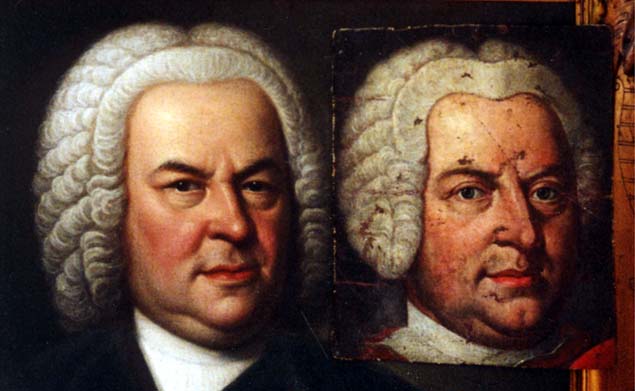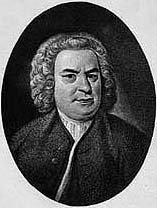The Critical Discographies from Choral Music On Records - Saint Matthew Passion Pages at the Teri Noel Towe Home Pages
Johann Sebastian Bach
The Critical Discographies from Choral Music On Records
This remarkable photograph is not a computer generated composite; the original of the Weydenhammer Portrait Fragment, all that
remains of the portrait of Johann Sebastian Bach that belonged to his pupil Johann Christian Kittel, is resting gently on the surface
of the original of the 1748 Elias Gottlob Haussmann Portrait of Johann Sebastian Bach.

1748 Elias Gottlob Haussmann Portrait, Courtesy of William H. Scheide, Princeton, New Jersey
Weydenhammer Portrait Fragment, ca. 1733, Artist Unknown, Courtesy of the Weydenhammer Descendants
Photograph by Teri Noel Towe
©Teri Noel Towe, 2001, All Rights Reserved
The Critical Discographies from Choral Music On Records
Saint Matthew Passion, BWV 244
Saint Matthew Passion, BWV 244
The Mendelssohn-Bartholdy Tradition
The 1741 performance of the Saint Matthew Passion appears to be the last that Bach himself presented. It was also the last
performance given for nearly 90 years. The vagaries of the preservation -- and loss -- of many of Bach's scores and performing
materials are too well known to warrant discussion here, but, by the 1820s, his music was well on its way to total rediscovery. Of
course, Mendelssohn-Bartholdy's revival of the Saint Matthew Passion was, to use a modern term, the media event that irreversibly
expanded Bach's audience to the world at large. Still, it is a common misconception that the performance that
Mendelssohn-Bartholdy gave with the Singakademie in Berlin on March 11, 1829, was complete and uncut. It was no such thing.
Four ariosos, ten arias, six chorales, and substantial portions of seven of the Evangelist's recitatives were excised, to reduce the
length of the work by more than an hour.
Among the numbers cut were such famous solos as "Aus Liebe will mein Heiland sterben" and "Mache dich, mein Herze, rein".
Mendelssohn-Bartholdy was also responsible for the custom of singing "Wenn ich einmal soll scheiden" a capella, a practice still
frequently encountered today, and of strengthening Bach's economical instrumentation of the "Earthquake" recitatives, another
practice that lingered well into this century; such shenanigans can be heard in the notorious Furtwängler concert recording, for
instance. In addition, Mendelssohn-Bartholdy was compelled to adjust the instrumentation by substituting currently available
instruments for those that had become "obsolete" since Bach's day; clarinets, for instance, replaced oboes d'amore and oboes da
caccia.
Neither the version that Mendelssohn-Bartholdy premièred in Berlin in 1829 nor the somewhat less severely cut version that he put
on in Leipzig a dozen years later has ever been recorded or, for that matter, given a "modern" performance. The performing
materials have been preserved; they are in the Bodleian Library at Oxford. A recording of either one of these arrangements, like a
recording of the 1727 version of the SMP, would be a valuable addition to the discography of this passion oratorio. {An excellent
HIP recording of Mendelssohn-Bartholdy's 1841 Leipzig Thomaskirche performing version has in fact been made in the years that
have passed since I wrote this discography. Under the direction of the innovative and sensitive Christoph Spering, this superb
recording on the Opus 111 label is an essential element of the collection of anyone who is interested in the history of the Bach
revival in general and in the revival of interest in the Saint Matthew Passion in specific.}
Whatever Mendelssohn-Bartholdy's motives may have been, his abbreviation of the SMP sanctioned the practice for all and sundry,
and, as others performed it throughout Germany, then England, and ultimately the world at large, the Saint Matthew Passion made
its "modern" début in a truncated form. It was not until 1912 that an audience finally heard this masterpiece complete and uncut.
{Thanks to the kindness of the distinguished Bavarian musicologist and critic Dr. Klaus-Peter Richter, I subsequently learned that
the first such complete and uncut performance had, in fact, taken place five years earlier, in 1907, in Karlsruhe, under the direction
of Felix Mottl.} The conductor was Siegfried Ochs, the founder and director of the Berlin Philharmonic Choir. Ironically,
notwithstanding his interest in Bach in particular and early music in general, Ochs was apparently a conservative interpreter.
Through the violinist Joseph Joachim, he stood in a direct line of pedagogical descent from Mendelssohn-Bartholdy himself, and
his brisk urgent tempos and long legato phrases have their origins in the essentially late Classical style in which both
Mendelssohn-Bartholdy and his colleagues in Berlin and Leipzig performed their own music and that of their antecedents. It comes,
therefore, as a shock for those who hear it for the first time to discover that Ochs's recording of the opening chorus of the SMP [7]
is the exact opposite of the ponderous and turgid interpretations, like the well-known Mengelberg performance, that they had
previously been misled to assume was the norm. Split over two sides of a 12" 78 with plenty of room to spare on the second side,
"Kömmt, ihr Töchter" last 5 minutes and 26 seconds, less than half the time it takes Mengelberg to make his stately and effusive
progress through the same music. {Those who are interested in exploring in further detail the issue of what the prevailing Bach
performance style of the 19th century actually was may wish to read Present-Day Misconceptions About Bach Performance
Practice in the 19th Century -- The Evidence of the Recordings.}
Like Bach himself, and Mendelssohn-Bartholdy, too, evidently, Ochs liked his tempos fast. One cannot help but wonder, under the
circumstances, if Hermann Scherchen's view of the SMP [8] was not strongly influenced by Ochs's. Scherchen was a native of
Berlin and received his early training there. His opening chorus is almost as fast as Ochs's, and his entire interpretation is notable for
its exceedingly fleet pacing. Like Ochs, too, Scherchen favors the clean cut and the straight forward; his phrases are long and
legato. Some of the contemplative movements may seem flippant at first, but the "turbae" choruses are especially dramatic at
Scherchen's tempos; never have the crowd's fury and the priests' hatred of Christ been more vividly conveyed to the listener.
The distinctive timbre of Hugues Cuenod's voice makes his Evangelist seem almost unearthly, and, despite the mildly dry character
of his voice, Heinz Rehfuss makes Jesus seem both warm and vulnerable. The other soloists run from the acceptable to the good,
but it is worth noting that Kurt Equiluz, one of the great Evangelists of our time, made his début as a soloist in SMP recordings as
the Second Witness in the Scherchen set.
If Ochs's tempos represented something of an extreme, what represented the norm among traditional, classic 19th century style
performances of the SMP in Germany? Who best represented the conservative Mendelssohnian Leipzig-Berlin approach to the
work? Gerhard Herz, the distinguished Bach scholar, recalls the conducting of Hans Weißbach as being the paradigm. [9] As it
happens, Weißbach was also a graduate of the Hochschule für Musik in Berlin, of which Joachim was the Director and at which
Ochs also had studied.
Fortuitously, a concert performance of the SMP under Weißbach's leadership has been preserved. [10] Recorded in the Altes
Gewandhaus on April 19, 1935, his interpretation is characterized by the same classical long legato phrases heard in Ochs's
recording of the opening chorus, but the overall tactus, while brisk, is not as fast as those adopted by Ochs or by Scherchen.
Another Mendelssohn-Bartholdyism in evidence is the beefed up instrumentation of the "Earthquake" recitative. Koloman von
Pataky is a thrilling Evangelist and tenor soloist: his positively ecstatic "Ich will bei meinem Jesum wachen" is challenged only by
the passionate full voiced Walter Widdop's 1930 English language version. [11] Margarethe Klose has a rather tight vibrato, but it is
compensated for by a solid chest tone and an emotionally searing "Erbarme Dich, mien Gott". Rather detached emotionally at first,
Paul Schöffler, the Jesus, warms up as the performance progresses. Kurt Böhme's big, dark, stirring voice brings a special power
to the bass arias, or at least those that are left in this cut performance. Also worthy of mention is Weißbach's particularly plastic and
affecting account of the final chorus.
The conservative Mendelssohnian approach to the Saint Matthew Passion centered in Leipzig and Berlin survives to the present,
despite the many subsequent and varying developments in Bach performance practice, including the Straube/Ramin style forged in
Leipzig in the 1920s and '30s. Several performances in this classic style have made their way to records since Ochs's and
Weißbach's work was documented.
The earliest among them is an abridged performance of the SMP recorded in Berlin in the mid '30s by the Bruno Kittel Choir under
the direction of its founder, Bruno Kittel, Ochs's successor as the German capital's foremost choral conductor. [12] Like Ochs and
Weißbach, Kittel preferred brisk tempos in the main, long legato phrases, and straight forward expression; there is no funny
business here. Kittel is blessed by a particularly well balanced group of soloists, all of whom have bright, firmly centered voices.
(Incidentally, the two separately released discs of excerpts that Kittel recorded are not taken from the complete set and feature
different soloists. [13]) The alto, the redoubtable Emmi Leisner, also made a splendid single disc of "Erbarme Dich, mein Gott".
[14] This especially poignant aria -- Bach certainly wrote none better -- appears to have been the most frequently recorded single
excerpt from the SMP during the 78 RPM era.
Among the most worthy such accounts are the dark voiced Sigrid Onegin's acoustic disc [15], the Dutch contralto Maartje Offers's
searing reading with the much under appreciated Isolde Menges playing the violin obligatto [16], and, from the post World War
Two era, the singular interpretation of Marian Anderson. [17] Although it is not of 78 RPM origin, one of the most transcendent
accounts of this heavenly aria was recorded by the mezzo-soprano Jennie Tourel at the 1951 Perpignan Festival, with Pablo Casals
conducting. [18]
More recent recordings of the SMP in the classic, Mendelssohnian manner include Fritz Lehmann's 1949 concert performance, the
first uncut recording in German. [19] The two previous German commercial "complete" recordings of the SMP -- the Kittel [12]
and the Günther Ramin [20] -- were abridged, as is Weißbach's performance. [10] Not identical but often congruent, these cuts are
not the same as those made by Felix Mendelssohn-Bartholdy; they are, however, indicative of the cuts that were the standard
throughout Germany as early as the last quarter of the 19th century, and, in the case of the Ramin recording, are the cuts that had
customarily been made in performances given by the Thomanerchor in Bach's "own" Thomaskirche in Leipzig since the early years
of the 20th century, at least. That the universal and "standard" cuts of the type found in the Kittel and Ramin recordings happen to
expunge most, if not all, of the specific references to the Jews is a now unfortunate and distasteful coincidence. And, of course, it
thus more than mildly ironic that it was left to American soloists, American instrumentalists, and American choristers, many of
whom were refugees from the Nazis, to record the first complete and uncut SMP in English in Boston on Good Friday, March 26,
1937, under the baton of a Soviet emigré, Serge Koussevitzky. [21]
Recorded at a concert in a divided and devastated Berlin, the Lehmann performance is among the greatest performances of the
Saint Matthew Passion on disc. His potent reading is squarely in the classic, Mendelssohnian tradition -- straightforward and
relatively brisk overall, with long, legato phrases and rhythmic robustness. Helmut Krebs was one of the great interpreters of the
tenor rôle; his distinctive, pure, and mildly nasal voice lends a particularly patrician quality to the Evangelist's narrative, and he sings
the tenor arias with nobility and commitment. The young Dietrich Fischer-Dieskau, then at the dawn of his career, is a magnificent,
virile Jesus; he may have refined and polished his interpretation over the years, but he never again sang the part with such youthful
freshness and naturalness. The other three soloists all possess solid, focused round voices.
It is frustrating, therefore, to have to report that the recording is marred by occasional snippets of missing music; a few measures,
for example, are missing from the opening ritornello of "Ich will bei meinem Jesum wachen". What the cause of these elisions was
is not clear, and a set of the Discophile Française 78s was not available for consultation. All is not lost, however, for the so-called
Joseph Balzer performance on the Royale label [22] is really the Lehmann, apparently taken off the air from the broadcast of the
same performance that was recorded for commercial release. The "Balzer" is, apparently, absolutely complete and not marred by
these unexplained "cuts". The Gramophone set (No relation to HMV!) featuring "The Cathedral Choir and Symphony Orchestra" is
identical to the "Balzer". [23]
Choruses and chorales from the SMP conducted by Karl Förster [24], who was for many years the choir director at St. Hedwig's
Cathedral, are also very Mendelssohnian in feeling: urgent and briskly paced, with long legato phrases. One wonders how the
Passion in its entirety sounded under Förster's capable leadership.
Kurt Thomas, who studied at the Leipzig Conservatory with Karl Straube before Straube became interested in issues of authentic
performance practice, made a recording of the SMP in the 1950s that is very much in the conservative, Mendelssohnian mold. [25]
His reading is cool and straight forward; frankly, it is the one truly inspired recording that Thomas made. It also is apparently the
earliest to make use of the 1741 versions of "Mein Jesus schweigt" and "Geduld, Geduld". A relatively small chorus and orchestra
are employed, and the soloists range from adequate to fine. As Jesus, Horst Günter is solid and direct, and Helmut Kretschmar's
fine account of the Evangelist and the tenor solos is marred by his tendency to shriek at the top. At a relatively early point in her
distinguished career, Agnes Giebel's voice is fresh, clear, and pure.
Heinz Markus Göttsche's recording [26] is much like Thomas's; it is direct and without pretension, a well sung, high quality
provincial performance in the conservative Mendelssohnian tradition; it also features the gamba versions of "Mein Jesus schweigt"
and "Geduld, Geduld". The recording, however, leaves something to be desired: The soloists are right in the listeners' laps, but the
chorus is in the next block. Of the reliable soloists, Ortrun Wenkel stands out; hers is a big, tubby contralto voice with a potent,
centered tone.
Much more impressive in every respect, however, is the Rudolf Mauersberger set, made in Dresden early in 1970. [27] It is the
quintessential recorded performance in the conservative Mendelssohn-Bartholdy style and one of the best accounts of the SMP
overall. Born in 1889, Mauersberger had been a student at the Leipzig Conservatory when Carl Reinecke, who had known
Mendelssohn-Bartholdy personally, was still an active member of the faculty. The performance is a splendid example of the
Mendelssohnian style at its best; from the first note to the last, it has a wonderful lilt. The phrasing is legato and long, and the tactus
relatively brisk. Mauersberger possessed an excellent sense of drama, and the performance is perfectly paced, with one number
leading into the next, powerfully but never melodramatically.
The two boys' choirs -- the Thomanerchor Leipzig, which was prepared by the then Thomascantor, Rudolf's younger brother
Erhard, and Rudolf's own Dresdner Kreuzchor -- sing with precision and with warmth. The soloists are at one with their
octogenarian conductor. A youthful Peter Schreier, himself an alumnus of the Kreuzchor, sings the Evangelist's rôle with brilliance,
conviction, and empathy; Hans-Joachim Rotzsch, who was to succeed Erhard Mauersberger as Thomascantor, has a pure light
voice, but it is a little tender at the top. Theo Adam is a wonderfully dignified and forthright Jesus, but his voice is beginning to
show the first signs of wear. The bass arias are sung by Günter Leib, whose light voice is precisely focussed and pure of tone.
The most recent recording of the SMP in the Mendelssohn-Bartholdy tradition, and the most colorful in the genre, is, surprisingly,
Sir Georg Solti's. [28] A native of Hungary, he grew up steeped in central European traditions of Bach performance practice and
had had four decades of experience conducting the SMP when he undertook to record it. Whether he did so consciously or not,
Sir Georg has given us another quintessential modern recording of a mid-19th century central German style reading of the score.
The tempos tend to be brisk, the approach straightforward; there is no simpering or lingering here. In short, this is another
performance in the best, conservative 19th century classic Leipzig/Berlin manner, and, because both the Lehmann and the
Mauersberger have been out of the catalogue for many years, is more readily available to those who are interested in this approach
to the SMP. {Both the Lehmann and the Mauersberger have been reissued on CD in recent years.}
The relatively small orchestra, a chorus some 80 voices strong, and the battery of top flight soloists acquit themselves nobly,
supporting Solti's interpretive goals to the fullest. Hans Peter Blochwitz, who sang the tenor arias in Herreweghe's period instrument
recording [5], here proves to be a distinguished Evangelist, and Kiri Te Kanawa is equally impressive in the soprano solos. Organ
continuo is used throughout, and the gamba versions of "Mein Jesus schweigt" and "Geduld, Geduld" are employed.
Sir Georg, however, is not the first "big name" conductor to record a great Saint Matthew Passion of the Mendelssohn-Bartholdy
type. That honor goes to Otto Klemperer, whose 1963 recording is justly revered. [29] The tempos and overall tactus, admittedly,
are slow, which creates an intensity that heightens the inevitability of the course of the story almost unbearably, but there is neither
simpering nor lingering. Furthermore, despite the deliberate pacing, the narrative recitatives never sound stodgy or didactic; they
have a suitably conversational tone about them. The phrases are long and smooth, the pacing paradoxically urgent and relentless.
No conductor has been blessed by a more stellar constellation of soloists for a recording of the Saint Matthew Passion, and all are
in top form. In fact, it has to be noted that some of the tiniest rôles are gladly taken by artists either at the peak of (Geraint Evans -
the Second Priest) or on the verge of (Janet Baker - the Second Maid) of major international careers. Klemperer, incidentally, opted
for the 1741 gamba versions of "Mein Jesus schweigt" and "Geduld, Geduld".
Please click here to advance to Page 3 - The Charismatic Iconoclasts
Endnotes
Alphabetical Discography
Please click here to return to the Critical Discographies from Choral Music On Records Main Page.
P. S.: Please don't forget that, if you are interested in a thorough, accurate discography of the recordings of the Saint Matthew
Passion that have appeared since the preparation of this article, you should go at once to Aryeh Oron's remarkable Bach Cantatas
Website.
Please click on  to return to the Johann Sebastian Bach Index Page.
to return to the Johann Sebastian Bach Index Page.
Please click on the  to return to the Teri Noel Towe Welcome Page.
to return to the Teri Noel Towe Welcome Page.
teritowe@alumni.Princeton.EDU
Copyright, Teri Noel Towe, 1989, 1997, 2001
All Rights Reserved
The The Critical Discographies from Choral Music On Records - Saint Matthew Passion Pages
at the Teri Noel Towe Home Pages are PPP Free web pages.

The The Critical Discographies from Choral Music On Records - Saint Matthew Passion Pages
at the Teri Noel Towe Home Pages have received the HIP Woolly Mammoth Stamp of Approval from The HIP-ocrisy Home Page.